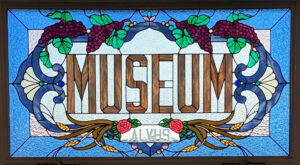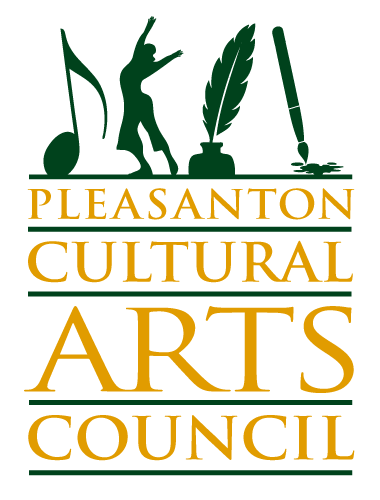Times Past
 Light plays with stained glass, illuminating and magnifying storied colors in the high transom window above the doors to the Museum on Main, 603 Main Street, Pleasanton. Like the sky itself, the window relies on transmitted light to enliven the artful assemblage of colors and tell its story. Margene Gerton Rivara created the Times Past window in 1983 for the Amador-Livermore Valley Historical Society. The sand-blasted letters ALVHS are inscribed at the lower center framed by symmetrical flowing leaves. The golden wheat sheaves are representative of the rich agricultural land, temperate climate, and abundant water source which in 1893 gave rise to hops growing. The Pleasanton Hops Company (1893-1906) shipped to London, the principal hops market. Today the industry is remembered with the naming of Hopyard Road.
Light plays with stained glass, illuminating and magnifying storied colors in the high transom window above the doors to the Museum on Main, 603 Main Street, Pleasanton. Like the sky itself, the window relies on transmitted light to enliven the artful assemblage of colors and tell its story. Margene Gerton Rivara created the Times Past window in 1983 for the Amador-Livermore Valley Historical Society. The sand-blasted letters ALVHS are inscribed at the lower center framed by symmetrical flowing leaves. The golden wheat sheaves are representative of the rich agricultural land, temperate climate, and abundant water source which in 1893 gave rise to hops growing. The Pleasanton Hops Company (1893-1906) shipped to London, the principal hops market. Today the industry is remembered with the naming of Hopyard Road.
A simple bold word, MUSEUM, obeys Art Deco style in its streamlined and geometric lettering. The announcement is necessary since the building erected in 1913-14, was first Pleasanton’s City Hall, then a Public Library and meeting place for the Women’s Improvement Club later again City Hall and the Police Department. By 1985, the building officially became Pleasanton’s museum.
Fusing elements of Art Noveau, elegant vine tendrils obey the symmetrical balance of Art Deco and slide over blue glue chip glass. Grapes and vines refer to the Villa Armando winery tasting room, which was at 553 St. John’s Street, Pleasanton. Vino Rustico was the premier product, winning numerous awards. One of the vineyards was near Vallecitos Road., Pleasanton. The roses represent the Jackson-Perkins rose, Don Juan, when Pleasanton was once called the “Rose Capital of the World” and fragrant rose fields blossomed from 1946-1964.
Stained glass windows require mastery in both artistic and technical realms. Capturing light in differing thicknesses of glass and varied colors requires skills as a draftsman, cutter, and engineer. The internal metal bracing of a window is critical for its long-term stability. Incorporating it into the design takes careful design artistry, fooling the most discerning eye.
Margene Gerton Rivara is a multi-talented accomplished artist. Once named one of the ten best stained-glass artists in the United States, Margene’s credits go beyond the P-Town Race stained glass window in the Pleasanton hotel and the women’s profile on 520 Main Street. She was also a contributing artist to the Pleasanton/Tulancingo mural in the City Hall Chambers, a designer of rugs (and holds 47 US Copyrights for rug designs), the chief designer of children’s clothing for Storybook Heirloom and stained-glass art teacher at her Rainbow Carousel on Main Street. She served as a founding board member of the Pleasanton Cultural Arts Foundation to raise money for the construction of the Firehouse Arts Center and was a significant financial contributor.
As light illuminates Times Past’s opalescent and textured glass, it beckons us to remember days gone by as we evolve into our tomorrow. If you look closely, you will see faceted jewels which foretell Margene’ s hope for a promising future.
Jan Coleman-Knight
